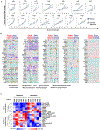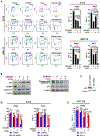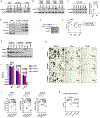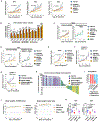MDM2 antagonists overcome intrinsic resistance to CDK4/6 inhibition by inducing p21
- PMID: 31413145
- PMCID: PMC7584132
- DOI: 10.1126/scitranslmed.aav7171
MDM2 antagonists overcome intrinsic resistance to CDK4/6 inhibition by inducing p21
Abstract
Intrinsic resistance of unknown mechanism impedes the clinical utility of inhibitors of cyclin-dependent kinases 4 and 6 (CDK4/6i) in malignancies other than breast cancer. Here, we used melanoma patient-derived xenografts (PDXs) to study the mechanisms for CDK4/6i resistance in preclinical settings. We observed that melanoma PDXs resistant to CDK4/6i frequently displayed activation of the phosphatidylinositol 3-kinase (PI3K)-AKT pathway, and inhibition of this pathway improved CDK4/6i response in a p21-dependent manner. We showed that a target of p21, CDK2, was necessary for proliferation in CDK4/6i-treated cells. Upon treatment with CDK4/6i, melanoma cells up-regulated cyclin D1, which sequestered p21 and another CDK inhibitor, p27, leaving a shortage of p21 and p27 available to bind and inhibit CDK2. Therefore, we tested whether induction of p21 in resistant melanoma cells would render them responsive to CDK4/6i. Because p21 is transcriptionally driven by p53, we coadministered CDK4/6i with a murine double minute (MDM2) antagonist to stabilize p53, allowing p21 accumulation. This resulted in improved antitumor activity in PDXs and in murine melanoma. Furthermore, coadministration of CDK4/6 and MDM2 antagonists with standard of care therapy caused tumor regression. Notably, the molecular features associated with response to CDK4/6 and MDM2 inhibitors in PDXs were recapitulated by an ex vivo organotypic slice culture assay, which could potentially be adopted in the clinic for patient stratification. Our findings provide a rationale for cotargeting CDK4/6 and MDM2 in melanoma.
Copyright © 2019 The Authors, some rights reserved; exclusive licensee American Association for the Advancement of Science. No claim to original U.S. Government Works.
Figures







References
-
- Gide TN, Wilmott JS, Scolyer RA, Long GV, Primary and Acquired Resistance to Immune Checkpoint Inhibitors in Metastatic Melanoma. Clin. Cancer Res 24, 1260–1270 (2018). - PubMed
-
- Robert C, Karaszewska B, Schachter J, Rutkowski P, Mackiewicz A, Stroiakovski D, Lichinitser M, Dummer R, Grange F, Mortier L, Chiarion-Sileni V, Drucis K, Krajsova I, Hauschild A, Lorigan P, Wolter P, Long GV, Flaherty K, Nathan P, Ribas A, Martin AM, Sun P, Crist W, Legos J, Rubin SD, Little SM, Schadendorf D, Improved overall survival in melanoma with combined dabrafenib and trametinib. N Engl J Med 372, 30–39 (2015). - PubMed
-
- Sosman JA, Kim KB, Schuchter L, Gonzalez R, Pavlick AC, Weber JS, McArthur GA, Hutson TE, Moschos SJ, Flaherty KT, Hersey P, Kefford R, Lawrence D, Puzanov I, Lewis KD, Amaravadi RK, Chmielowski B, Lawrence HJ, Shyr Y, Ye F, Li J, Nolop KB, Lee RJ, Joe AK, Ribas A, Survival in BRAF V600-mutant advanced melanoma treated with vemurafenib. N Engl J Med 366, 707–714 (2012). - PMC - PubMed
-
- Young RJ, Waldeck K, Martin C, Foo JH, Cameron DP, Kirby L, Do HD, Mitchell C, Cullinane C, Liu W, Fox SB, Dutton-Regester K, Hayward NK, Jene N, Dobrovic A, Pearson RB, Christensen JG, Randolph S, McArthur GA, Sheppard KE, Loss of CDKN2A expression is a frequent event in primary invasive melanoma and correlates with sensitivity to the CDK4/6 inhibitor PD0332991 in melanoma cell lines. Pigm Cell Melanoma R 27, (2014). - PubMed
Publication types
MeSH terms
Substances
Grants and funding
LinkOut - more resources
Full Text Sources
Other Literature Sources
Research Materials
Miscellaneous

